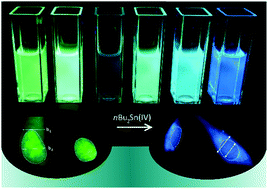Organotin(iv) differential fluorescent probe for controlled subcellular localization and nuclear microviscosity monitoring†
Abstract
A dual-emissive fluorescent probe enabling dynamic changes in nuclear local microviscosity monitoring was developed. The new sensing scenario involves probe subcellular localization redistribution, allowing a quantitative analysis of the local microviscosity related to nuclear damage in the presence of agents perturbing the nuclear morphology. With the aid of an organotin(IV) in situ formed complex we propose a different scenario of bioanalytical applications through confocal microscopy.

- This article is part of the themed collection: Celebrating Latin American Talent in Chemistry


 Please wait while we load your content...
Please wait while we load your content...